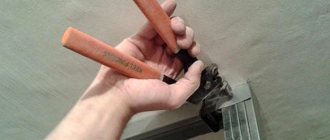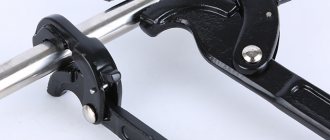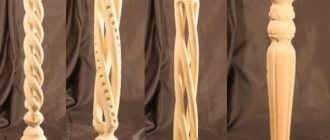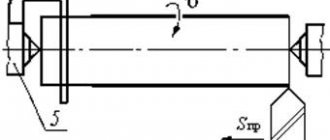Today, drywall is very popular. It is used to level walls, create partitions and decorative structures. GKL is mounted on a metal profile lathing, the individual elements of which are fastened with special self-tapping screws. At the same time, their caps sometimes interfere with the tight fit of the plasterboard sheets. To avoid this, a drywall cutter is increasingly being used.
What it is?
This tool began to be used in construction not so long ago. Most ordinary users and home craftsmen have little idea what a cutter for a drywall profile is, how it works, and on what principle it works.
Externally, the tool resembles pliers: it has 2 handles, one of which has a bracket attached to the end. A cutting element (punch) is installed on the second of them. The principle of operation is also very simple: 2 profiles are combined, the connection point is placed between the bracket and the punch, the handles are pressed, and a hole appears on the metal (it is also called a groove), which holds the profiles in a given position. Some devices on the reverse side press the protruding edges tightly, some do not.
Types of cutters
There are 3 types of cutters for metal profiles for drywall:
- regular manual;
- reinforced;
- professional.
They are all designed the same, but have some differences. First of all, this is the load for which they are designed and operating conditions.
Manual cutters are small in size. They fit comfortably in one hand. Most often, this type of tool is used by home craftsmen. Their safety margin is quite enough for small repairs in an apartment, and they cost much less than their professional counterparts.
Reinforced cutters are most often purchased by small construction teams. These tools are made from stronger alloys. They also differ slightly in design: they usually have a removable punch, which is easy to change if it gets dull. Thanks to this, the tool will last longer.
USEFUL INFORMATION: Putty for sealing drywall joints: which one to choose and which one is better
Professional tools are usually used for large volumes of work. They are larger and more massive than their analogues, more powerful, and can penetrate thicker profiles. Of course, such a cutter costs much more than its “brothers”. There is no point in purchasing it if you plan to build one partition.
These features must be taken into account when choosing a tool. The most popular at the moment are reinforced cutters.
When choosing a suitable device, you need to pay attention to several more parameters:
- Thickness of the metal being pierced. For example, 0.55 mm is the standard thickness for manual models; a reinforced cutter is capable of making a hole in a profile 1.5 mm thick.
- Hole diameter. Varies from 2 to 5 mm depending on the choice of interchangeable bits that come with the tool.
Drywall profile cutter - a tool for quickly connecting profiles
Partitions, ceilings, and false walls are often built from plasterboard. And it is mounted on a frame made of metal profiles. A significant part of the time is spent on installing this very frame. A metal profile cutter allows you to reduce time without losing quality. This is a hand-held tool that joins two profiles in seconds.
What is a sheet metal cutter?
A cutter or punching pliers is a hand-held tool for joining sheet metal products. The connection occurs due to the formation of a through hole in the parts being connected.
The parts to be connected are fixed by bending the resulting metal petals.
That is, to connect sheet metal products using a cutter, no fasteners or additional actions are required.
We placed the working part of the tool in the right place and pressed the handles. The metal breaks through, its pieces bend. All. Due to the fact that the metal is “pierced”, another name for this tool came to be - a profile punch.
The same tool can be found under the name “pliers for connecting HA profiles.” This is exactly how some manufacturers position it. There are other names - perforation, profile hole punch.
This is already from the jargon of builders and home craftsmen.
Metal profile cutter: roller type device
Externally, a cutter is the same pliers, but with long handles and an unusual structure of the working part. Like regular ticks, they have two jaws, but they are different in shape. On one side there is a stop, on the other there is a punch. A punch is a protruding part that makes a hole in metal. The stop is a thickened part with a hole into which the punch fits.
Photo of how the cutter works. He makes a through hole in the parts to be connected and bends the metal petals
The shape of the working part is designed so that the metal petals that are formed when making a hole are slightly bent. This ensures reliable fixation of the products relative to each other. The hole shape is usually rectangular, but can be square or round. Rectangular is preferable because it gives a more “rigid” connection.
Pros and cons of using cutters
This type of instrument is not very popular yet. It’s difficult to name the reasons, because the thing is really good. Especially for those who install plasterboard systems, and for home craftsmen, this is also a necessary thing. What are the advantages:
- Fast and reliable connection of profiles. The speed of installation of the frame under drywall increases significantly. The principle of operation is simple: insert the parts to be joined between the jaws, squeeze the handles, move, repeat. And so on as many times as required. Punch for drywall profile. This is also what this instrument is called.
- No need to use fasteners. This saves time and money.
- The tool is hand-held, so no electricity is needed. You can work on any objects.
- There is no protrusion at the junction of the profiles. When mounted with rivets or self-tapping screws, the head protrudes above the surface of the profile. Self-tapping screws have more, rivets have less. This prevents the sheet of drywall from laying flat without bending. When using a cutter, the bends remain on the “wrong” side of the profile. The front is obtained without protrusions. The sheet lies flat, which reduces the time for putty and its consumption. For installing drywall, the absence of protrusions is definitely a plus
Few of those who have tried to work as a cutter return to self-tapping screws. Although, I must say, there are some. Sometimes in difficult places, the connection is “grabbed” with a self-tapping screw, then a cutter is used, and the self-tapping screw is unscrewed. But these are those who like to play it safe. With some work skill, additional fixation is not required.
Flaws
Now about the cons. Using a plasterboard profile cutter really saves time. But the tool is manual and requires the application of muscle force.
With large volumes of installation, namely structures made from profiles, fatigue quickly accumulates. And by the end of the working day, the speed of work drops.
The better the tool, the less effort is required, but it is still needed. And this is a minus.
The second drawback is the difficulty of disassembling. To separate the two profiles, you need to bend the metal petals. It takes more time than when unscrewing screws. But less than when removing rivets. It seems that these are all the difficulties and disadvantages of working with a cutter.
Not everywhere you can crawl up and make a cut. Then you have to use screws and a screwdriver
There is another drawback, which is due to the shape of the working part. Some components - jumpers, clamps - are simply impossible to “reach” with a cutter. The punch won't fit in there. There are models with very large “windows”, but they are not very good for regular connections. For professionals, having several different models is normal, but for home use it is clearly overkill.
Self-tapping screws or notches
It has already been said that when using cutters the sheet lies flatter. And this is a clear plus in favor of the expanded connection. The second unconditional plus is saving time. The third is the lack of consumables.
The disadvantages of joining GK profiles with a cutter include insufficient fastening strength. Self-tapping screws are more reliable. Perhaps, but the strength of the frame is needed only until it is sheathed with gypsum boards. And it will be enough, even if you make only one fastener for each connection. But it’s up to you to decide which is better - a cutter or self-tapping screws.
The assortment of cutters in our stores is not so large, but in large construction stores you can see about a dozen different models. What are they? First, there are models for sheet metal (pictured below).
They have a very small gap in the working part, which is also called a “window”. For sheet metal cutters, this window is only about a centimeter wide.
Any metal will fit there, but the profile for drywall is only a guide (PN) or rack-mount (PS) with small shelves. And then there may be problems.
A cutter for a metal profile should have a larger “window” in the working part
If we talk about models for connecting drywall, they have a larger “window”. It is made in the form of a square, rectangle or with rounded corners.
The larger the window, the easier it will be to fasten rack profiles with any shelf width. But then the size of the “head” increases, which is not always convenient.
Professionals simply have several different tools, and for repairs and household use they choose something in between.
This is already a tool for professionals - with holes of different sizes and shapes
There are also different shapes of holes: rectangular, round, square. They come in different sizes. The thicker the metal, the larger the punch (or bit) required. There are models with replaceable punches, and there are rotary ones.
For rotary or revolving ones (pictured above), the attachment is changed by turning a wheel with bits of different shapes and sizes. If you plan to work with sheet metal often, this is a good thing.
For occasional use, such luxury is unnecessary.
You can fasten profiles near the ceiling and floor with a regular tool, but it is more convenient to work with a special
There is also a cutter for metal profiles for convenient fastening of profiles under the ceiling or near the floor. Their handles are not a continuation of the working part, but are installed at an angle. Some (Ultra Profil EDMA) are at an angle of 90°, others are at 45°. This tool further speeds up the work when creating frames for suspended ceilings.
One-handed and two-handed and principle of operation
It is also worth remembering that there are one-handed and two-handed models. One-handed ones have a return spring that opens the handles after the tension is removed.
Working one-handed is far from easy. Especially on good profiles made of normal metal. So often one-handed ones are still operated with two hands. In this case, the procedure for working with the cutter for KG profiles is as follows:
How the cutter works: it pierces both profiles, bends the edges inward
- We set profiles by level.
- With your left hand we fix them in the desired position.
- Tool on the right. We bring its working part to the desired point, compress it until the bit hits the metal.
- We remove our left hand (the profiles are “held” by the cutter), and squeeze the handles with both hands.
Two-handed work is different in that the handles are at such a distance that you can’t even grab them with one hand. Well, they are also designed to connect thicker metal.
How to choose a cutter for a metal profile
Perhaps the most difficult thing is choosing a specific cutter model. They are divided, as usual, into household and professional. The difference in price is more than noticeable. The cheapest and most acceptable quality ones can be purchased for about $10, normal ones from $20-30, and really good ones can cost $100 or more.
Profile cutter for drywall: which one to choose
What is the difference? In work resource and ease of use. This means that the more expensive ones use more durable and expensive metals, rubber and plastic for handles, etc.
They have a more complex design of the working part; there is a mechanism that reduces the force required for connection. In general, there is something to pay for.
But nevertheless, for periodic work, for the home, you can find quite good and functional specimens in the cheap segment.
The difference in the working part between a regular inexpensive cutter and a professional one
When choosing a cutter for a profile from any category, look at the following parameters:
- Maximum thickness of fastened parts. Please note that the total thickness of metal that this tool can penetrate is indicated. That is, if 1.2 mm is indicated, this means that you can take two sheets of 0.6 mm or 0.8 mm + 0.4 mm, but not two sheets of 1.2 mm.
- Shape and size of the “window”. Rounded corners make work easier.
- The presence of a roller that pushes the punch. Such models are more expensive, but require much less effort.
- The case is free of defects, cavities, cracks, massive and heavy.
- We evaluate ergonomics. The handles should be comfortable, with stops.
- It is ideal if the handles have rubberized inserts. Otherwise, you will have to work with gloves - there will be calluses.
- The handles can be grasped with one hand when extended.
For professionals, such a tool is a godsend, but for amateurs and home craftsmen the price is too high
And it is very desirable that the company be well-known. Although, there are also nameless “Chinese” ones that are very good for home use.
Benefits of using a cutter
Installation of profiles using a cutter is noticeably different from the classical method, which involves the use of self-tapping screws. The advantages that this type of fastening has:
- savings on consumables - self-tapping screws;
- no additional tools (drill, screwdriver) are required for installation;
- profiles are not deformed;
- there is no risk that the screw will go too far;
- no need to waste time on marking;
- a hole is punched much faster than a self-tapping screw is screwed in;
- the holes have smooth, neat edges, nothing sticks out of them;
- no dents on the frame;
- does not consume electricity;
- The connection is reliable, but if necessary, it can be quickly and easily disassembled.
Many builders, after working with a cutter, abandon self-tapping screws, since the process of assembling a metal frame is significantly accelerated and simplified.
Metal profile cutter
Published on August 10, 2017 in the category Building materials // 0 comments // Author: Admin
- 5
- 4
- 3
- 2
- 1
(0 votes, average: 0 out of 5)
The distribution of drywall is becoming wider and wider. This universal material is used in installing partitions, creating false ceilings, and leveling walls. But drywall is only the outer part of the structure; it is attached to a durable (usually metal) profile frame. Often frame elements need to be fastened together. Many people use self-tapping screws for this purpose. But to tighten them, you need a screwdriver, which is not always convenient to carry with you, as it is quite bulky. He also needs to charge his batteries from time to time. Therefore, it is better to master working with a tool such as a cutter for a metal profile for drywall.
What is a cutter and what is it for?
This is an indispensable tool if you work with drywall and metal profiles. Used for quickly fastening profiles together. Works like a stapler, cutting holes in metal. Among the advantages of the cutter, we note:
- Fast response - just one click and a few seconds of your precious time, and the profiles are linked together
- Quality - the mount is quite reliable and durable
- Convenience - does not require any skills at all, here everything is decided by your hand strength when pressing
- Saving - no additional materials are needed, such as self-tapping screws or self-tapping screws
- Does not wrinkle the surface, does not cause any distortions or bends
The device of the cutter, the principle of operation
The cutter is a fairly simple tool to use. Its main parts:
- Fixed handle
- Bracket
- Punch
- Movable handle
The fixed handle is firmly attached to the bracket. The bracket itself has two legs, they have recesses for a punch. Between these legs there is a profile that needs to be fastened. The movable handle is connected through a roller to the punch. The punch is a cylinder that cuts holes, fastening the profile surfaces together.
How to use the tool
Using a cutter for a metal profile for drywall will not require any special skills or special abilities from its owner. The frame elements are connected very simply:
- profiles are aligned relative to each other and fixed in the desired position;
- the handles of the cutter are moved as far as possible in different directions;
- the ear is placed so that the connection point is between the lip and the cutting element;
- the handles are squeezed sharply, as a result the punch makes a hole in the profile;
- the handles are again moved apart and the tool is moved to the side or removed.
USEFUL INFORMATION: How to hem a ceiling with plasterboard with your own hands (video instructions)
Thus, the profiles are connected to each other.
Types of cutters for connecting metal profiles
Installation of plasterboard structures can be done in two main ways: on an adhesive base and using a metal frame. Despite the fact that the second option slightly reduces the area of the room, its use is more preferable. In this case, the best option for attaching the guides to each other is a cutter for a plasterboard profile, which allows you to achieve maximum strength of the sheathing.
This is what one type of profile cutter looks like. Return to contents
Full contents of the material
Using a cutter for metal profiles: positive aspects and purpose of the device
Installation of a metal profile frame is an important step in cladding various surfaces or creating new interior partitions. To fix the guides together, the best option is to use a cutter, since it can significantly speed up construction work. This device has many positive qualities due to its design features. They look like this:
- does not depend on the power grid;
- does not leave any irregularities on the front surface of the profile;
- does not require fasteners;
- creates a strong and reliable connection;
- easy to operate.
All these qualities make the profile cutter for drywall an indispensable device designed to optimize installation work and make it more economical. At the same time, the quality of the connection is not inferior to self-tapping fasteners, and in some aspects exceeds it. However, the scope of application of the device is limited exclusively to the installation of metal profiles among themselves. Fixing a wooden frame under drywall or fastening stiffeners to the wall surface cannot be done with its help.
Such work is carried out exclusively with the help of self-tapping screws, which provide good adhesion to the initial surface of the wall or floor. Based on the purpose of the device, we can summarize that the profile cutter is a narrow profile, but quite functional and useful tool for drywall.
Design of a cutter: main elements and types of devices
The profile cutter for drywall has a fairly simple device based on the application of physical force. Due to its small size, it falls into the category of hand tools. The device consists of several functional units, among which the most important is the breakdown mechanism. It includes a roller, a stop and the punch itself. It is these three elements that are responsible for the performance of the device. A high-quality mechanism not only ensures durability of its use, but also does not leave torn edges, punching holes as accurately as possible.
An important aspect when choosing a cutter is the size and shape of the bracket that ensures grip of the profile. The elongated and wide connector ensures a better fit of the device to the surface of the profile, which allows its fastening to be carried out as accurately and efficiently as possible. Based on the penetration capability, there are the following types of cutters:
- Manual ordinary.
- Manual reinforced.
- Professional.
Types of cutters
Which option to choose depends on the person’s needs and desires. Each of these types has its own specific characteristics and scope of application. In this case, the simplest and cheapest is an ordinary manual cutter, and the most expensive is a pneumatic professional model. The difference between them lies precisely in the penetrating ability.
It is expressed in the permissible profile thickness, which is indicated on the handle and is the maximum permissible for a particular type of device.
Important! For use at home, it is better to choose a reinforced cutter. Thickened handles and wide axles make the mechanism more reliable, which affects its functionality and durability. A pneumatic device is used to process large volumes of profiles, and its use at home is simply impractical due to its indecently high cost.
Operating principle and cost of various device models
The operating principle of the cutter is always the same and is based on the action of physical force, which creates a mechanical torque through a lever. When you press the movable lever, it feeds the punch into the eye, and the roller additionally fixes it. Depending on the applied force, the mechanical component acting on the metal also changes. In this case, the main lever remains stationary and holds the punching mechanism, creating all the necessary conditions for the operation of the device.
An example of the correct use of a cutter
The punch passes through the metal base, leaving a hole in it. At the moment of penetration, the iron edges of the two profiles bend outward, interlocking with each other. The result is an excellent attachment point that can withstand the applied loads. In this case, several punctures are made for better fixation.
Important! A distinctive feature of using a cutter is the absence of any irregularities on the front side of the profile. The serrations go inward and, unlike the use of self-tapping screws, do not interfere with the further installation of drywall sheets.
Today, on the shelves of construction stores there is a wide range of cutters, differing in their appearance and functionality. However, their purpose does not change depending on the design and is to speed up the process of installing a metal frame. Depending on the manufacturer of the device, its price also varies, which can differ significantly:
- Sparta - 400-500 rubles;
- Matrix - 800-1 thousand. R.;
- Stanley - 8-10 thousand rubles;
- Bison - 800-1 thousand. R.;
- Knauf - 5-6 thousand rubles;
- Knipex - 10-12 thousand rubles.
As you can see, choosing a good cutter is not so difficult. Moreover, in some cases, cheap models are not inferior to more expensive models. Therefore, the choice of a specific device model is based solely on a person’s financial capabilities and personal preferences.
How to use the device and its features
Do-it-yourself drywall installation becomes much easier with the use of a cutter. However, to obtain a high-quality and reliable connection, you must adhere to a certain sequence of actions, which looks like this:
- profiles for partitions must be adjacent to each other at right angles;
- there cannot be free space between the bases of the profiles; they must fit as tightly as possible;
- the handles of the cutter are moved in different directions, freeing the entrance to the bracket;
- the connector is put on the metal profile at the place of future fastening;
- the punching mechanism is pressed tightly against the profile at an angle of 90 degrees;
- the handles sharply move towards each other;
- when the punch moves, a click is heard confirming its passage through the base of the profile;
- the handles are moved apart again, and the device itself is removed.
The result of this sequence of actions will be a small through hole in the profile with jagged edges inside. To increase the load-bearing capacity of the structure, each joint must be cut at least a couple of times. As a rule, 2-3 holes are enough to secure a sheet of drywall, provided that the framing technology is followed.
Holes made by a cutter
If the pitch between the posts is exceeded or the number of stiffening ribs is insufficient, the stability of the sheathing is sharply reduced, and the seams may not withstand the increased load. In such cases, it is better to use self-tapping screws for the profile, and leave the cutter to create technologically correct structures.
Conclusion
A cutter for metal profiles under plasterboard is an indispensable device designed to universalize installation work and significantly speed it up. The principle of its operation is to adhere metal profiles to each other without the use of additional fasteners. The quality of the coupling is at a fairly high level, which allows reducing the overall costs of constructing the frame. At the same time, it is not necessary to buy an expensive cutter, since even inexpensive models provide excellent profile fixation. The only thing you need to consider when choosing it is the penetration ability, which is indicated on the handle.
Tips for use
A cutter is a very simple and undemanding tool, however, it also requires proper care and compliance with certain rules:
- most cutters are designed for a total profile thickness of no more than 1.5 mm;
- you can’t make breakthrough breakthroughs;
- hitting is also prohibited;
- The cutter must be placed strictly perpendicular to the plane of the profiles being pierced;
- you cannot make a breakdown in the place where the profile is built up or joined;
- The hinges need to be lubricated periodically.
A profile cutter for drywall is a simple and convenient tool. Even a beginner can assemble a frame with its help.











